

The DMS&T program is an investment mechanism that allows the department to advance the state-of-the-art for defense-essential manufacturing capability, through the development of technologies and processes necessary for the production of defense systems. The Air Force Research Laboratory and the Defense Production Act Title III program have been working on this material since 2006 when DPA Title III was improving manufacturing processes to improve the powder that is used to form transparent armor and infrared sensor windows. It begins as a powder that is formed into unique shapes and made transparent through the application of high temperature and pressure. This provides the warfighter with superior protection for both air and ground vehicles.ĪLON is a transparent ceramic material composed of aluminum, oxygen and nitrogen. The transparent ceramic armor provides superior ballistic protection at less than half the weight and thickness over traditional glass laminates.
TRANSPARENT HALF WING WINDOWS
With a growing need in the Department of Defense for transparent armor for personnel protection and infrared windows for reconnaissance applications, the Air Force Research Laboratory along with the Defense-wide Manufacturing Science and Technology program, support the manufacturing of aluminum oxynitride products providing greater system performance. It’s a fairly standard buffet spread, with some made-to-order options, too.WRIGHT-PATTERSON AIR FORCE BASE, Ohio – Transparent aluminum, a technology first suggested in the science fiction film “Star Trek IV: The Voyage Home,” is now a reality. Golden Cowrie also hosts the adults-only breakfast, if you’re keen to maintain the serenity offered by the Reef Wing. The setting is stunning, with an outdoor deck overlooking the lagoon. My top pick is the Golden Cowrie Coastal Italian Restaurant, which offers surprisingly authentic Italian fare – the pasta is all handmade. With four restaurants and two bars, there’s a good amount of variety to see you through your stay. The resort has a clinic where you can do this on-site – it costs FJ$48 (NZ$35) per person. There’s also a tour desk where you can book excursions.Īt the time of writing, Fiji requires visitors to pre-book a supervised rapid antigen test, to be taken within 72 hours of arrival. There’s a shopping arcade with a Prouds (which stocks those lovely Pure Fiji products), a Jack’s of Fiji (good for beachwear), and convenience store. The inflatable waterpark can also be enjoyed by the young at heart. This wing, dubbed the Reef Wing, is largely separate to the rest of the resort, with its own entrance and lobby, as well as an exclusive infinity pool and bar. But in 2019, the resort completed a US$50 million (NZ$80 million) refurbishment, which included converting one of the three wings into an adults-only precinct. To get around, you can walk, or hitch a ride on a golf buggy – friendly staff will whisk you to where you want to go.Īs well as being one of Fiji’s biggest resorts, the Shangri-La is also one of the oldest, having opened in 1967. The grounds are so sprawling you’re given a map on arrival, and it definitely takes a day or two to get your bearings. Well, not exactly to yourself – you’ll be sharing with all the other guests staying in the 443 rooms, suites and bures. The spaceĪlso unlike Denarau, which is home to nine resorts and hotels, you have a whole island to yourself when staying at the Shangri-La, which is the only resort on the 109-acre Yanuca Island. The adults-only Reef Wing is largely separate to the rest of the resort.


 0 kommentar(er)
0 kommentar(er)
